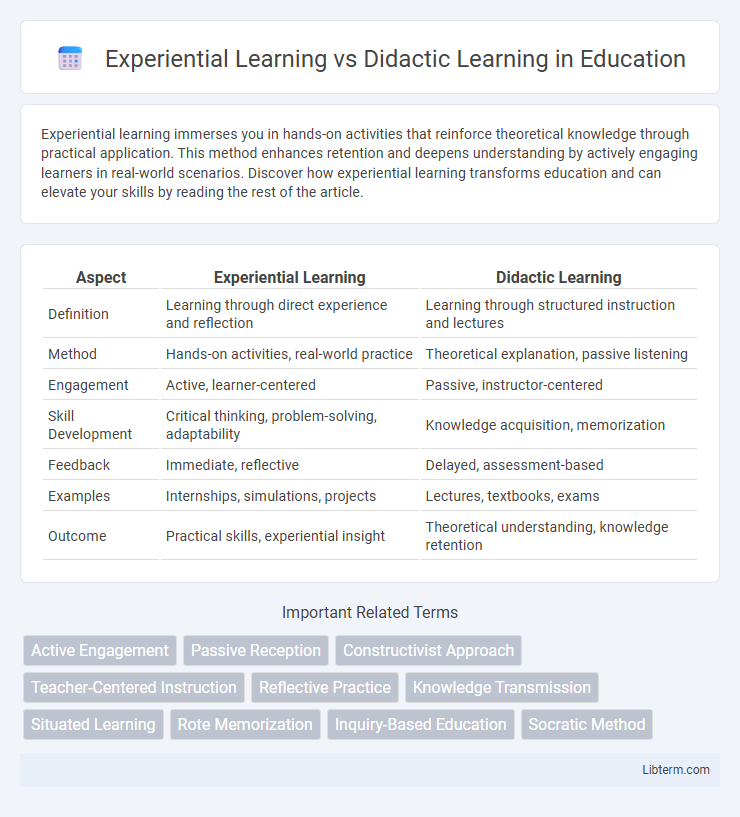Experiential learning immerses you in hands-on activities that reinforce theoretical knowledge through practical application. This method enhances retention and deepens understanding by actively engaging learners in real-world scenarios. Discover how experiential learning transforms education and can elevate your skills by reading the rest of the article.
Table of Comparison
| Aspect | Experiential Learning | Didactic Learning |
|---|---|---|
| Definition | Learning through direct experience and reflection | Learning through structured instruction and lectures |
| Method | Hands-on activities, real-world practice | Theoretical explanation, passive listening |
| Engagement | Active, learner-centered | Passive, instructor-centered |
| Skill Development | Critical thinking, problem-solving, adaptability | Knowledge acquisition, memorization |
| Feedback | Immediate, reflective | Delayed, assessment-based |
| Examples | Internships, simulations, projects | Lectures, textbooks, exams |
| Outcome | Practical skills, experiential insight | Theoretical understanding, knowledge retention |
Introduction to Experiential and Didactic Learning
Experiential learning emphasizes hands-on, interactive experiences that engage learners in real-world problem solving, fostering deeper understanding through active participation. Didactic learning relies on structured, instructor-led delivery of knowledge, typically through lectures and presentations, focusing on theoretical comprehension. Combining these approaches enhances educational outcomes by balancing practical application with foundational knowledge acquisition.
Defining Experiential Learning
Experiential learning is a hands-on educational approach that emphasizes learning through direct experience, reflection, and application, enabling learners to develop skills and knowledge by actively engaging in real-world tasks. Unlike didactic learning, which relies on passive absorption of information through lectures or reading, experiential learning fosters critical thinking, problem-solving, and retention by immersing learners in practical activities. This method is grounded in theories by educational pioneers such as David Kolb, who highlighted the cyclical process of concrete experience, reflective observation, abstract conceptualization, and active experimentation.
Understanding Didactic Learning
Didactic learning emphasizes structured, instructor-led teaching methods where information is delivered systematically through lectures, textbooks, and presentations. This approach prioritizes knowledge acquisition and factual understanding, often relying on memorization and repetition. It is effective for conveying foundational concepts and theoretical frameworks in a clear, organized manner.
Key Differences Between Experiential and Didactic Approaches
Experiential learning emphasizes active participation and real-world experience, fostering critical thinking and problem-solving skills through hands-on activities. Didactic learning relies on structured instruction and passive reception of information, prioritizing memorization and theoretical understanding. The key difference lies in experiential learning's learner-centered approach versus didactic learning's teacher-centered model, impacting engagement and knowledge retention.
Benefits of Experiential Learning
Experiential learning enhances critical thinking and problem-solving skills by engaging learners in real-world scenarios, which promotes deeper understanding and retention of knowledge compared to didactic learning's passive reception of information. It fosters active participation, collaboration, and adaptability, essential for developing practical competencies in dynamic environments such as healthcare, business, and technology. This hands-on approach also improves motivation and self-confidence, leading to higher academic achievement and better preparation for professional challenges.
Advantages of Didactic Learning
Didactic learning offers structured knowledge delivery through expert-led instruction, ensuring foundational concepts are clearly communicated and uniformly understood. This method allows for efficient coverage of extensive material within limited timeframes, making it ideal for large groups or standardized curricula. The predictability and control in didactic learning facilitate consistent assessment and benchmarking of learner comprehension.
Challenges and Limitations of Both Methods
Experiential learning faces challenges such as resource intensity, variable learner engagement, and difficulty in standardizing assessments, which can limit its scalability and consistency. Didactic learning struggles with passive student involvement, reduced retention rates, and limited opportunities for practical application, often leading to disengagement and superficial understanding. Both methods require careful integration of complementary strategies to overcome their inherent limitations and maximize educational effectiveness.
Practical Applications in Education and Training
Experiential learning emphasizes hands-on activities that immerse students in real-world scenarios, fostering critical thinking, problem-solving, and adaptability essential for practical applications in education and training. Didactic learning relies on structured instruction and information delivery, ensuring foundational knowledge through lectures, textbooks, and assessments, which supports theoretical understanding. Combining experiential methods with didactic approaches enhances skill acquisition and knowledge retention, preparing learners for effective performance in professional environments.
Choosing the Right Approach for Different Learners
Selecting the optimal learning method depends on learners' goals, preferences, and contexts; experiential learning emphasizes hands-on, active participation that enhances critical thinking and problem-solving skills, while didactic learning focuses on structured, instructor-led knowledge delivery suited for foundational understanding. Learners with practical, kinesthetic tendencies benefit more from experiential approaches that promote real-world application and retention, whereas those requiring theoretical frameworks or standardized content may thrive under didactic methods. Blending both approaches can accommodate diverse learning styles, fostering comprehensive mastery and engagement across varied educational settings.
Future Trends in Educational Methodologies
Experiential learning, characterized by hands-on, immersive activities, is gaining momentum as future educational methodologies emphasize personalized, adaptive, and technology-driven experiences. Didactic learning remains foundational but is increasingly integrated with digital simulations, virtual reality, and AI-powered tools to enhance engagement and knowledge retention. Emerging trends highlight a shift towards hybrid models that blend direct instruction with experiential components to prepare learners for complex, real-world challenges.
Experiential Learning Infographic

 libterm.com
libterm.com